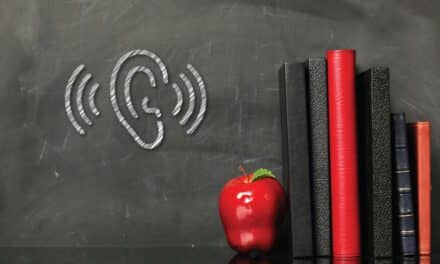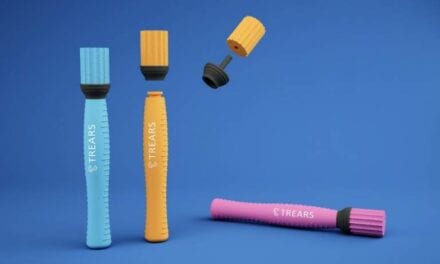Editor’s Note: This book excerpt is an abridged version of chapter 12 from The Masking Handbook (For Audiometry) by Duncan Floyd, which details how and why to use Robert Turner’s Optimized Method of masking to complete masked, threshold testing when the hearing between a patient’s ears is asymmetrical.
For an expanded discussion with the author about this method, listen to The Hearing Horizons Podcast: Duncan Floyd on Masking—The Optimized Method
In 2004, Robert Turner described the Optimized Method in two articles: “Masking Redux I: An Optimized Masking Method” (1) and “Masking Redux II: A Recommended Masking Protocol.” (2)
The Optimized Method of masking is an efficient way to complete masked, threshold testing when the hearing between the ears is asymmetrical. When one ear is significantly better than the other, Turner’s method is recommended. The method is used when the poorer ear is the Test Ear (TE). When hearing is more symmetrical, the Plateau Method is recommended.
I’ve used this approach for years while working in an ENT setting where complex, asymmetrical hearing situations are common. It’s accurate, prevents overmasking, can be used for both air and bone-conduction testing and it also works for speech-recognition threshold testing.
And it saves a lot of time.
Plateau Method vs. Optimized Method
When using the Plateau Method, we determine the Initial Masking Level (IML) based on the status of the Non-Test Ear (NTE). We “build up” the masking from the NTE hearing thresholds. Since the NTE is the one that must hear the masking signal, it ensures that a certain Active Masking Level (AML) gets delivered.
The Optimized Method uses the Test Ear as the reference for choosing the IML. Although masking still gets presented to the NTE, we use the hearing threshold value of the TE and “drop down” from there to get an initial presentation value.
The beauty of the Optimized Method is how it focuses on situational, interaural attenuation (sitIA) characteristics. Turner observed that an audiometric situation sometimes provides a more accurate IA perspective than the minimum, known-possible (minIA) values.
Don’t forget: the IA values that we think about during audiometry are likely to underestimate how much attenuation is present in a given situation. We reference the lowest known values that can occur. These are collected from the audiometric literature and help guide our decision-making on when to use masking. For example, when the minIA value is exceeded during air-conduction audiometry, we recognize that masking is required because we can’t ensure that the test signal is being heard by the TE. We also think about the minIA values when delivering masking noise: when masking noise exceeds the minIA value, we become concerned about overmasking. It’s possible the masking signal may cross to the Test Ear and contaminate the ear we want to measure.
Regarding minIA, however, most test subjects will have higher attenuation characteristics.
Turner proposed that individual IA values can sometimes be recognized which are more helpful than rote, minIA ones. Referencing Studebaker (1964) (3)and Martin (1974) (4), he observed that the situation itself sometimes reveals a more accurate reflection of IA.
This allows us to make decisions on masking levels that would otherwise be avoided.
Situational Interaural Attenuation
Recognizing a sitIA permits an initial masking level (IML) to be louder than what is typically used. Sometimes the IML may be close to a maximum masking level. The method, however, avoids overmasking.
The IML is determined by taking the unmasked threshold (for the specific test signal) of the TE and subtracting 10 dB from that value. Masking is then presented to the NTE at this level.
TE HTL = Test Ear Air Conduction Hearing Threshold Level
IML = TE HTL – 10 dB
Here is an example for unmasked, air-conduction at 1000 Hz: we have a threshold in the right ear at 0 dB HL and a threshold in the left ear at 70 dB HL. The difference between the two exceeds our minIA value. For the left ear, we can’t be certain that we’re testing the ear we want to test. We must complete masked testing to explore the issue.
IML = TE HTL – 10 dB
IML = 70 dB – 10 dB
IML = 60 dB
Our IML that is delivered to the right NTE will be a 1000 Hz NBN signal with an intensity of 60 dB.
(In contrast, if we used the Plateau Method, our IML might be 15 dB HL.)
An initial, masked threshold is then measured from the TE. If the new threshold remains the same as the unmasked threshold, a valid, masked threshold can be accepted. As a safety check, masking could also be increased by 5-10 dB and the threshold retested. This acts as a “mini-plateau” clarifier within the Optimized Method.
When a Threshold Shifts
Following the initial masking level, a threshold might also shift. When this occurs, masking is increased to the NTE and the testing continues. The masking level increases by the amount that the TE threshold shifted with the IML present.
Let’s revisit our 1000 Hz, air-conduction case. If we introduce the 60 dB IML to the NTE right ear (which has the 0 dB unmasked threshold) and the left TE threshold then shifts to 90 dB, we know that the 70 dB threshold in the left ear was not valid. We therefore increase the masking by the amount that the TE threshold has shifted. In this case, the TE shift was 20 dB HL. We increase the masking by that amount: masking is presented at 80 dB and retesting continues. In this way, the masking level remains 10 dB below a current, tested threshold response of the TE.
In theory, masking levels can go as high as the TE, air-conduction value and not overmask. A quick, mini-plateau up to this value is possible to confirm the results. Increase the masking noise another 5 or 10 dB and validate that the threshold is stable. Once confirmed, we know that the masked threshold is on the “plateau” and a valid, TE threshold has been obtained.
The IML test will result in either:
- An immediate masked threshold which will be on the “plateau” portion of the masking curve.
- A shifted hearing threshold. This means that the unmasked measurement was not coming from the Test Ear. Increase the masking level by the amount that the hearing did shift and retest again.
Overmasking Not an Issue
Clinicians accustomed to using the Plateau Method are sometimes taken aback by the high levels of masking that you start with and the high levels of masking that may conclude the process. How can these levels not result in overmasking?
Turner produced a framework to support the approach. Despite the (often) high IMLs, the Optimized Method does not produce overmasking.
He observed that an air-bone gap—even an unmasked one—can reflect subject-specific interaural attenuation better than the population-based minIA values we normally reference. No matter which ear an unmasked, bone-conduction threshold comes from, its relation to an elevated threshold from the Test Ear can provide a sitIA value. The interaural attenuation value cannot be less than an air-bone gap. Even an unmasked, air-bone gap.
There are two possibilities with an unmasked, bone-conduction threshold: it might represent the cochlear hearing of the NTE or it may reflect the cochlear hearing of the TE.
If the unmasked, bone-conduction threshold comes from the cochlea of the NTE (i.e., the ear that is opposite to the one we’re trying to test), we can compare it to the air-conduction threshold of our Test Ear. The IA cannot be lower than this resulting value. If the IA were lower, then the TE air-conduction response would have crossed over to the NTE cochlea at a lower dB level. If the IA was lower than this crossed, air-bone gap, the TE air-conduction threshold would not be permitted at the current level.
If the unmasked, bone-conduction threshold comes from the cochlea of the TE, we have an air-bone gap present on the Test Ear side. This value still represents a minimum, situational IA.
VIDEO: https://youtu.be/xC0YjiH4A-o?si=nK9QZqo6JHSXYxei
OPTIMIZED METHOD: TEST EAR LEVEL AND THE 10 dB REFERENCE
Crossover represents the point at which signals enter the bone tissues of the head. In this case, if the IA were lower than the air-bone gap on the TE side, the signals would have entered the cranial bones at a lower level. If this had occurred, the TE cochlea would have detected them. An air-bone gap from either side reflects a minimum-possible transmission level to the cranial bones. We have the cochlear hearing documented at a certain level; we measure the air conduction threshold which is higher than this B/C value. The difference between the two is the air-bone gap. There are two options regarding the A/C value: it has found its way through the outer/middle ear pathway and entered the ipsilateral cochlea. Or else it has entered the bone tissues of the head and gotten to the cochlea via bone-conduction.
Hear More on Masking for Audiometry on the Hearing Horizons Podcast:Duncan Floyd on Masking—The Optimized Method
If an unmasked, air-conduction threshold is 70 dB and the unmasked, bone-conduction threshold for the same signal is 0 dB, we know that the IA must be at least 70 dB. If the IA value were lower, then we’d know that the air-conducted sound would have entered the bone tissues at a lower level: the air-bone gap would have to be less than 70 dB. If the IA value was lower than 70, then the air-conduction threshold would have been lower than 70 dB.
An air-bone gap, even an unmasked one, provides another perspective—a situational value—on interaural attenuation.
Once a new, sitIA value is recognized, it provides opportunities for a different masking approach. We can immediately deliver louder initial masking noise safe in the knowledge that it will not cross to our TE and contaminate our threshold measures.
Our population-based, minIA for that same signal and earphone might be 50 dB. With this approach, if we apply masking above 50 dB, we start thinking about the possibility of overmasking. Using the Optimized Method, we abandon this 50 dB value and identify a much higher IA for the individual. We can then happily deliver up to 70 dB of masking noise to the NTE without worry about it crossing to the TE.
If we deliver masking to the NTE at a level of 60 dB, we know that we’re below the sitIA for that signal, phone, and head. There will be no crossover of the masking noise.
We can, in fact, increase the masking up to 70 dB without overmasking. We’ve staked a claim on 70 dB being our IA. A 70 dB masking noise to the NTE will therefore not impact a 0 dB bone-conduction threshold measure in the TE. The active masking (AML) value on the opposite side will be 0 dB. It will not prevent the listener from detecting the signal at least 50% of the time.
When using the Optimized Method for asymmetrical hearing losses, we accept that masking noise in the NTE (i.e., the better ear) can be delivered at a level as high as the air-conduction hearing threshold of the TE with no risk of overmasking.
This maxim is actually independent of the bone-conduction situation. For example, if we mask our 70 dB air-conduction threshold with a 60 dB masking noise to the NTE, the threshold might shift up to 90 dB HL. At this threshold level, we either have 90 dB air-bone gap or else the TE bone-conduction threshold is greater than 0 dB. In this case, we’d increase the masking noise by that shift amount (20 dB) and retest. In this manner, the masking noise—now at 80 dB—remains 10 dB below the known, updated, A/C threshold response. In theory, we could go as high as 90 dB and still not overmask. The 70 dB sitIA protects us from overmasking if the initial, bone-conduction assumption was incorrect. If the TE bone-conduction threshold actually is 0 dB, then the IA must be greater than 70 dB.
When using the Optimized Method for bone-conduction, a similar approach is used. If an initially masked, bone-conduction threshold shifts 20 dB from the unmasked, previously measured, B/C response, then masking is increased by that 20 dB value. Will overmasking occur? The answer is “no.” We’ve already established the sitIA value. We know that the Optimized IML is safe. If the masked, B/C response shifts once the IML is introduced, a similar increase in masking will not result in overmasking. The sitIA provides us with a maximum possible crossover. An increase in crossover might occur, but the known status of the TE cochlea has changed: we’ll understand that the cochlea of the TE will not be affected by this crossover increase. The situation will be free from overmasking.
The Optimized Method sometimes results in a high level of masking noise. For example, if an initially-masked, air-conduction threshold in a TE shifts to 100 dB, then 90 dB of masking noise is permitted in the NTE. If the NTE threshold happens to be 0 dB, that is a loud blast of noise! As Turner observed: the Optimized Method can provide a very high ceiling limit for masking intensity but it doesn’t mean that we must always mask up to that ceiling. If patient comfort is a concern, it’s often fine to reduce the masking level by a slight, discretionary amount. It’s important to keep the sitIA value in mind when doing this, however, so that an undermasking situation is not created.
When considering the Optimized Method, Turner recommended that the difference in thresholds between the TE and the NTE should be at least 25 dB.
My personal approach is to quickly compare the proposed IMLs that might be used for the Plateau and Optimized Methods. Whichever method begins with a higher IML becomes the preferred approach.
Key Concepts for the Optimized Method
The ideas propping up the Optimized Method revolve around several assumptions that should be identified:
- If we adopt 0 dB as the interaural attenuation for bone-conduction, we recognize that this is a theoretical construct.
- We assume that the Situational IA values—which are deduced from examining pure-tone test signals—apply to masking noise signals as well.
- We assume that a conclusion drawn by examining a signal radiating from right to left (e.g., from the TE to NTE side) can also apply to a signal that is delivered in the opposite direction (e.g., masking noise from the NTE to the TE side).
The Optimized Method of masking is an effective, easy, and efficient addition to a clinician’s toolkit.
Duncan Floyd, MSc AuD, Reg. Audiologist, has been an audiologist for almost 30 years and has practiced in Canada, China, and the USA. He has clinical experience with both pediatric and adult caseloads and has worked in an ENT environment for over 20 years. For over a decade, Duncan was the clinical coordinator for audiology and a lecturer at Dalhousie University’s School of Communication Sciences and Disorders in his home province of Nova Scotia, Canada. He currently works in Halifax, Nova Scotia in an ENT clinic, is an adjunct professor at Dalhousie teaching acoustic immittance measures, and is co-owner of Accessible Hearing Solutions. He is author of The Masking Handbook (for Audiometry).
References
1. Turner RG. Masking redux. I: An optimized masking method. J Am Acad Audiol. 2004;15(1):17-28. doi:10.3766/jaaa.15.1.4
2. Turner RG. Masking redux II: A recommended masking protocol. J Am Acad Audiol. 2004;15(1):29-46. doi:10.3766/jaaa.15.1.5
3. Studebaker GA. Clinical masking of air- and bone-conducted stimuli. J Speech Hear Disord. 1964;29:23-35. doi:10.1044/jshd.2901.23
4. Martin FN. Minimum effective masking levels in threshold audiometry. J Speech Hear Disord. 1974;39(3):280-285. doi:10.1044/jshd.3903.280
For more information about The Masking Handbook (For Audiometry) by Duncan Floyd, including where to purchase, visit https://maskinghandbook.com.





